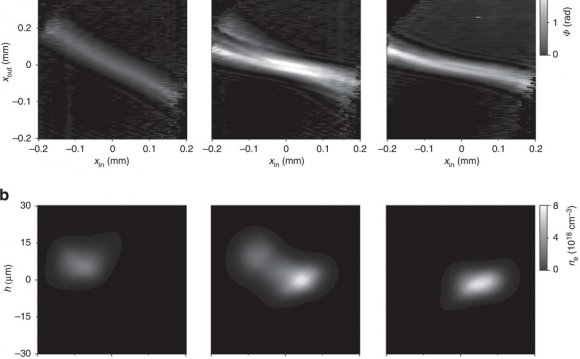
 Time-resolved dynamics of plasma formation and bulk refractive index modification in silica glasses excited by a tightly focused femtosecond (110 fs) Ti:sapphire laser was first observed in situ. The newly proposed pump–probe measurement with perpendicularly linear polarized beams was used to study the dynamic of both plasma formation and induced refractive index bulk modification. The energy variation of transmitted probe beam with time delay, which propagates through the induced plasma is measured. At the pre-breakdown domain, the lifetime of induced plasma formation is ∼15 ps and structural transition time for forming the refractive index change is ∼10 ps. At the breakdown domain, however, the lifetime of induced plasma formation is ∼35 ps and structural transition time for forming the optical damage is ∼35 ps. We found that the process of refractive index bulk modification is significantly different from that of optical damage. According to the electron spin resonance (ESR) spectroscopic measurement, it was found that the defect concentration of SiE' center increased significantly in the modified region in related to that of the region without modification. From the diffraction efficiency of Kogelnik's coupled mode theory, the maximum value of refractive index change (Δn) was estimated to be 1.1×10−2. By the scanning of silica glass on the optical X–Y–Z stages, the fabrication of the internal grating with refractive index modification was demonstrated in silica glass using tightly focused femtosecond laser. The experimental results will be helpful to understand the physical mechanism of the plasma and structural transformation induced by tightly focused high-intensity femtosecond lasers in transparent materials.
Time-resolved dynamics of plasma formation and bulk refractive index modification in silica glasses excited by a tightly focused femtosecond (110 fs) Ti:sapphire laser was first observed in situ. The newly proposed pump–probe measurement with perpendicularly linear polarized beams was used to study the dynamic of both plasma formation and induced refractive index bulk modification. The energy variation of transmitted probe beam with time delay, which propagates through the induced plasma is measured. At the pre-breakdown domain, the lifetime of induced plasma formation is ∼15 ps and structural transition time for forming the refractive index change is ∼10 ps. At the breakdown domain, however, the lifetime of induced plasma formation is ∼35 ps and structural transition time for forming the optical damage is ∼35 ps. We found that the process of refractive index bulk modification is significantly different from that of optical damage. According to the electron spin resonance (ESR) spectroscopic measurement, it was found that the defect concentration of SiE' center increased significantly in the modified region in related to that of the region without modification. From the diffraction efficiency of Kogelnik's coupled mode theory, the maximum value of refractive index change (Δn) was estimated to be 1.1×10−2. By the scanning of silica glass on the optical X–Y–Z stages, the fabrication of the internal grating with refractive index modification was demonstrated in silica glass using tightly focused femtosecond laser. The experimental results will be helpful to understand the physical mechanism of the plasma and structural transformation induced by tightly focused high-intensity femtosecond lasers in transparent materials.
PACS
- 42.55.−f;
- 42.65.Jx;
- 42.81.Wg
Keywords
- Time-resolved dynamics;
- Refractive index modification;
- Plasma formation;
- Silica glass;
- Femtosecond laser
YOU MIGHT ALSO LIKE












